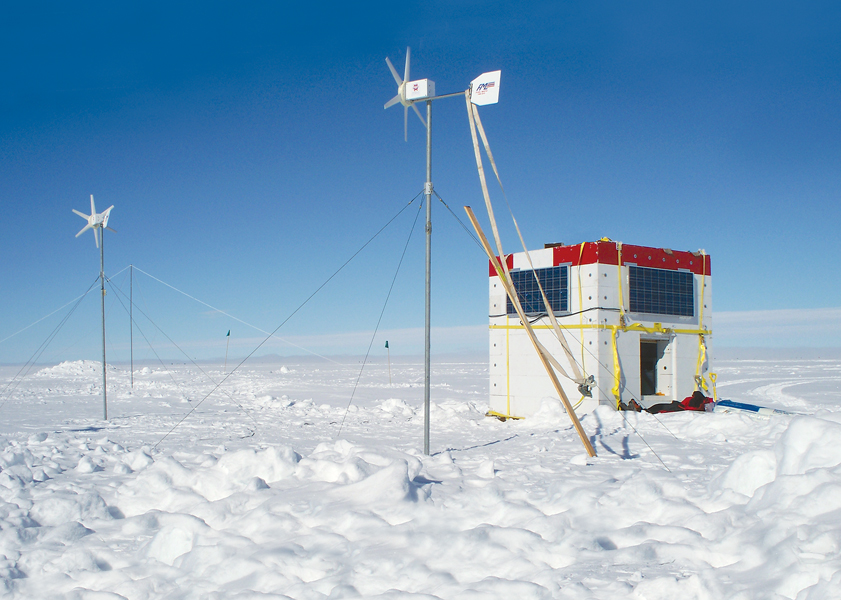The Little Observatory That Could
ANTARCTICA IS THE COLDEST, WINDIEST, DRIEST spot on our planet and is bathed in darkness six months a year. Not the easiest place for scientists to gather data. But design a robot of sorts to do the job for you and a stream of vital information pours forth 24/7, 365.
That’s precisely what scientists from the Space Science Center, as part of a multi-institutional, collaborative team, have achieved with the successful deployment of the Autonomous Real-time Remote Observatory at Antarctica’s McMurdo Station.
Called ARRO for short, the observatory is a heavily insulated, eight-foot modular cube powered by solar and wind energy.
The maintenance-free facility uses only a small bank of batteries and two five-gallon water jugs to act as “phase change material” to store the thermal energy needed to keep things operating.
The observatory sends it’s data back in real-time by passing it off relay-race style to a series of satellites circling the globe like “cell phone towers in space,” says co-investigator for the project, EOS space physicist Marc Lessard. The data stream received via Iridium satellite phone ultimately gets captured by an antenna perched atop Morse Hall almost directly above Lessard’s EOS office.
With darkness now engulfing the South Pole, the observatory is running on the power generated only by three, small wind turbines working in parallel. “It’s down there now chugging away,” says Lessard, who compares the observatory to “The Little Engine That Could” for its ability to keep on keeping on despite hardships.
When the wind dies down and any residual power and heat is used up, the whole unit goes into a state of torpor called “cold soak.” “Everything freezes, and when the wind comes back the whole system powers up again, chugga, chugga, and we start getting data again,” he says.
ARRO is the latest in a generation of observatories that gather data on the interaction of solar wind energy with Earth’s magnetic field lines, which arc high above our atmosphere and connect at both the North and South poles. Gathering such information in Antarctica is significantly more challenging in comparison to the more populated and relatively milder northern polar region.
But, notes Lessard, “The global electrical circuit is incredibly complicated and there are a lot of gaps in our knowledge about how it works. In order to fully understand the phenomena we’re studying, you have to know what happens with the field lines at both the poles.”
That’s precisely what scientists from the Space Science Center, as part of a multi-institutional, collaborative team, have achieved with the successful deployment of the Autonomous Real-time Remote Observatory at Antarctica’s McMurdo Station.
The Autonomous Real-time Remote Observatory
at McMurdo station in Antarctica. Photo by Chris Seymour, UNH-EOS |
The observatory sends it’s data back in real-time by passing it off relay-race style to a series of satellites circling the globe like “cell phone towers in space,” says co-investigator for the project, EOS space physicist Marc Lessard. The data stream received via Iridium satellite phone ultimately gets captured by an antenna perched atop Morse Hall almost directly above Lessard’s EOS office.
With darkness now engulfing the South Pole, the observatory is running on the power generated only by three, small wind turbines working in parallel. “It’s down there now chugging away,” says Lessard, who compares the observatory to “The Little Engine That Could” for its ability to keep on keeping on despite hardships.
When the wind dies down and any residual power and heat is used up, the whole unit goes into a state of torpor called “cold soak.” “Everything freezes, and when the wind comes back the whole system powers up again, chugga, chugga, and we start getting data again,” he says.
ARRO is the latest in a generation of observatories that gather data on the interaction of solar wind energy with Earth’s magnetic field lines, which arc high above our atmosphere and connect at both the North and South poles. Gathering such information in Antarctica is significantly more challenging in comparison to the more populated and relatively milder northern polar region.
But, notes Lessard, “The global electrical circuit is incredibly complicated and there are a lot of gaps in our knowledge about how it works. In order to fully understand the phenomena we’re studying, you have to know what happens with the field lines at both the poles.”
by David Sims, Science Writer, Institute for the Study of Earth, Oceans, and Space. Published in Winter 2009 issue of EOS .

